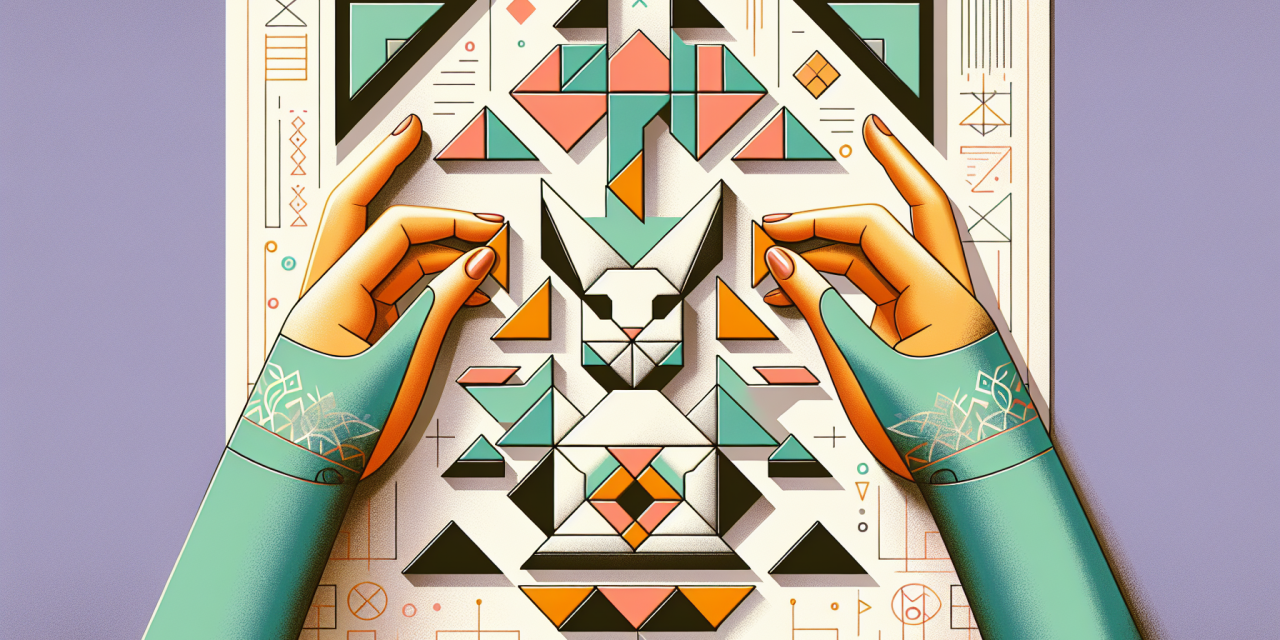Picture this: You’re holding seven simple geometric shapes — a square, a parallelogram, and five triangles of different sizes. Your challenge? Create a perfect rabbit silhouette using every single piece, with no overlaps and no gaps. Welcome to the wonderfully frustrating world of tangram puzzles, where creativity blooms within the tightest possible constraints.
If you’ve never encountered tangrams before, you might wonder how something so simple could captivate puzzle enthusiasts for over a thousand years. After all, we’re talking about just seven pieces! But here’s where it gets interesting: those seven humble shapes can form over 6,500 different recognisable figures. That’s like having a tiny universe of possibility sitting in your palm.
The Beautiful Prison of Rules
What makes tangrams fascinating isn’t their freedom — it’s their restrictions. Every tangram puzzle operates under three non-negotiable rules: use all seven pieces, never overlap them, and create a completely filled shape with no empty spaces. These constraints might seem limiting, but they’re actually the secret ingredient that makes tangrams magical.
Think of it like writing a haiku. You’re constrained to exactly seventeen syllables arranged in three lines, yet within those boundaries, you can capture the essence of a sunset, the loneliness of winter, or the joy of discovery. The rules don’t crush creativity — they channel it into something focused and powerful.
In coding, we encounter this same phenomenon constantly. Programming languages have strict syntax rules. You can’t just write “make the computer do something cool” and expect it to work. Instead, you must follow precise formatting, use specific keywords, and structure your logic in particular ways. Yet within these constraints, programmers create video games, space missions, and apps that connect people across continents.
Pattern Recognition in Action
When you’re working on a tangram puzzle, your brain starts noticing patterns everywhere. That large triangle? It often forms the body of animals or the base of buildings. The parallelogram frequently becomes a head or a roof. The small triangles might be ears, tails, or decorative elements.
This is exactly how computational thinking works. We learn to recognise common patterns and apply solutions we’ve seen before to new problems. Software developers call this “design patterns” — proven templates for solving recurring programming challenges. Just as you might recognise that certain tangram piece combinations work well for creating four-legged creatures, programmers learn to spot when specific code structures will solve particular types of problems.
The more tangram puzzles you solve, the faster you become at seeing these patterns. Your mind builds a library of “piece relationships” that help you tackle new challenges. One day, you look at a puzzle of a house and immediately know that the square will form the main structure, while the triangles will create the roof and chimney.
The Art of Systematic Exploration
Here’s where tangrams really start to mirror computational problem-solving. When you’re stuck on a particularly tricky puzzle, you don’t just randomly shuffle pieces around (well, maybe for the first few minutes!). Eventually, you develop a more systematic approach.
You might start by identifying the most distinctive features of your target shape. Is there a long straight edge? That probably involves the parallelogram or the large triangle. Does the shape have a narrow protrusion? Time to experiment with the small triangles. This process of breaking down complex problems into smaller, manageable pieces is called decomposition, and it’s one of the fundamental skills of computational thinking.
Experienced tangram solvers often work methodically through possibilities. They’ll place the largest pieces first, since these have the fewest possible positions, then work their way down to the smaller, more flexible pieces. This mirrors how programmers often tackle complex software projects — start with the major components and architecture, then fill in the detailed functionality.
When Constraints Spark Innovation
The most surprising thing about tangrams is how those rigid constraints actually push you toward creative solutions you’d never consider otherwise. When you’re trying to create a cat and your usual “triangle for the head” approach isn’t working, you’re forced to think differently. Maybe the parallelogram can form the head? Or perhaps two small triangles arranged cleverly?
This constraint-driven creativity appears everywhere in technology. Twitter’s original 140-character limit didn’t kill communication — it birthed an entirely new, concise form of expression. Video game designers working with limited processing power created some of the most ingenious and memorable games in history, precisely because they had to be creative within strict technical boundaries.
The same principle applies to coding challenges and programming competitions. When you’re asked to solve a problem using only certain functions or within specific memory limits, you often discover elegant solutions that you would have overlooked if given unlimited resources.
Building Mental Models
As you work with tangrams over time, something fascinating happens in your mind. You start developing what cognitive scientists call “mental models” — internal representations of how the pieces work together. You begin to visualise rotations and transformations without physically moving the pieces.
This spatial reasoning transfer beautifully to programming, where you need to build mental models of how data flows through your code, how different functions connect to each other, and how changes in one part of your program might affect other parts. The ability to “see” these relationships in your mind before writing the code is what separates novice programmers from experienced ones.
Tangrams also teach you about transformations — how the same piece can serve completely different functions depending on its orientation and position. A triangle pointing up might be a tree, but rotate it 180 degrees and it becomes a mountain or a boat’s sail. This flexibility of perspective is crucial in computational thinking, where the same data structure or algorithm might solve vastly different problems depending on how you apply it.
The Meditation of Systematic Thinking
There’s something deeply satisfying about the methodical testing of possibilities that tangrams encourage. Unlike many modern puzzle games that offer hints or allow unlimited do-overs, tangrams require patience and systematic exploration. You place a piece, evaluate the result, adjust, and try again.
This mirrors the debugging process in programming, where you methodically test hypotheses about what might be causing a problem. You change one variable, run your code, observe the result, and iterate. It’s a calm, logical process that trains your mind to approach problems systematically rather than frantically.
The beauty lies in the fact that every arrangement teaches you something, even the “wrong” ones. Each failed attempt eliminates possibilities and narrows your search space. In programming, we sometimes joke that debugging is like being a detective in a crime story where you’re also the murderer. Tangrams have that same quality — you’re both creating the challenge and solving it through patient investigation.
What makes tangrams such perfect preparation for computational thinking is their combination of rigid structure with infinite possibility. Within those seven simple shapes and three inflexible rules lies a universe of creative problem-solving that has captivated curious minds for generations. Every time you place that final piece and watch a perfect silhouette emerge from apparent chaos, you’re experiencing the same satisfaction that programmers feel when their code finally runs exactly as intended — the joy of bringing order to complexity through patient, systematic creativity.








